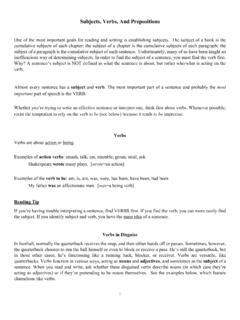Transcription of GRAMMAR: PART I
1 ACADEMIC STUDIES ENGLISH Support Materials and Exercises for grammar : part I parts of speech FALL 1998 PARTS OF SPEECHACADEMIC ENGLISHACKNOWLEDGEMENTSThe following persons have contributed to the development of this learning material:Content and Structure:Curriculum Developer(s) Leslie Curriculum Content Expert New Brunswick Community Supervision/Co-ordination:Angela Co-ordinatorNew Brunswick Community Co-ordinatorNew Brunswick Community document is available full-text on the World Wide Web thanks to the National Adult Literacy Database.
2 Financial support for this learning materials project was provided by the National Literacy Secretariat of Human Resources Development 1998 This support module may be used with BAU-ENG , parts of speech , and IAU-ENG Parts of PARTS OF SPEECHOBJECTIVEUpon successful completion of this unit, the learner will be able to 1. identify the eight parts of speech in simple sentences. 2. explain the function of each part of POINTSL evelNoun1common and proper3/42singular and plural3/43possessive nouns (with s)3/44used to name people, places, things3/4 Pronoun5personal, indefinite, interrogative3/46use to replace nouns3/4 Verb7identify verbs and verb phrases ( walk, walks, walked,3/48 is walking, has walked, has been walking, etc.)
3 3/49singular and plural forms of to be (present, past, future)3/410singular and plural forms of to have (present, past, future)3/411use of basic verb tenses (past, present, future)3/412principal parts of common irregular verbs 3/413uses to express action and state of being3/4 Adjective14used to describe nouns and pronouns3/415comparison of adjectives5/616 use of er ending to compare two things 5/6 17 use of est ending to compare two or more things5/618 use of more and most with longer adjectives5/619comparison of irregular adjectives good, better, best5/6 Adverb20used to describe verbs: where, why, when, how, how much3/421usually end in ly 3/422comparison of adverbs.
4 Quickly, more quickly, most5/6quicklyPreposition23used to show space and time relationship between nouns5/6 Conjunction24used to join complete thoughts5/6 Interjection25used to express surprise, horror, or other strong emotions3/4 Learners should be encouraged to use their own writing as well as traditional exercises toidentify parts of PARTS OF SPEECHOBJECTIVESUpon successful completion of this unit, the learner will be able to 1. identify the eight parts of speech in written and oral 2. describe the function of each part of POINTSL evelNouns1 Types: common & proper7(naming)2 concrete & abstract73 singular & plural 74 possessive (with boy s, boys and Charles 7 Pronoun5 Types: personal (gender, number, person, case)7(naming)6 interrogative, indefinite77 reflexive, reciprocal, demonstrative, emphatic88 relative8/9 Verb9 Type: action & linking7(stating:action/existence)10 helping (auxiliary) & main = verb phrase711 active & passive voice912 Principal parts: regular & irregular713 Tense.)
5 Simple (past, present, future)714 perfect (past, present, future)715 progressive (past, present, future)716 perfect progressive (past, present, future)8 Adjective17 Types: common & proper7(describing)18 demonstrative719 articles (a, an, the)720 Comparison of adjectives: regular and irregular7 Adverb21 Types: regular ( ly ) & irregular7(describing)22 negative ( not, never); quantitative ( of adverbs: regular & irregular7 Preposition(joining)24 Types: simple & compound ( in/in front of)7 Conjunction(joining)25 Types: co-ordinate (and, but, or, nor, for, yet, so)726correlative (either/or, neither/nor, not only/but also)727conjunctive adverb ( therefore, thus, etc.))
6 728subordinate conjunction: ( because, if, when,8/929relative pronoun ( that, which, who, etc.)9 Interjection30expressing horror, surprise, is the key to developing mastery of this objective. Practice sentences can be found in everygrammar text, in newspapers and magazines, as well as in the learner s own writing. Learners shoulddevelop a hands-on approach to identifying parts of speech by regularly using their own writing as asource of practice TO FACILITATORS AND first grammar module, parts of speech , presents information and exercises toaccompany the objectives of BAU-ENG , parts of speech and IAU-ENG , Parts of this module marked with an asterisk (*) should be completed by learnerswanting to complete the BAU-ENG working in IAU-ENG should complete all sections of this module.)
7 If they havepreviously completed the BAU-ENG programme, those sections marked with an asteriskshould be are free to use any support materials appropriate to their learners resource materials may be required for those wanting more information on thistopic or for those needing more practice mastering certain support materials may be should be very familiar with the parts of speech before they attempt Module 6,Parts of the terms are not always consistent. Where possible, this module indicates alternateterminology and ways of handling specific grammar situations. Learners should befamiliar with these, so that a wider variety of source materials are accessible to The accompanying Practice Booklet contains exercises and an answer key in support ofspecific teaching points.
8 Many exercises may, however, be used to practice identifying avariety of parts of is essential to mastery of parts of speech . Learners will benefit from using theirown writing, newspapers, magazines, and novels as a source for practice sentences. real purpose for learning grammar is to help learner write and speak as effectively NOT write in this module. Please make your notes and complete the exercises in yourown notebooks so that other learners may also use these OF IS grammar ?..1 WHY STUDY grammar ?..2 WHAT ARE THE parts of speech ?.. CLOSER LOOK AT for forming possessive CLOSER LOOK AT PRONOUNS.
9 25A CLOSER LOOK AT parts of the of verb CLOSER LOOK AT CLOSER LOOK AT CLOSER LOOK AT COMMON grammar ..63 FEEDBACK The root word morph means The etymology of syntax shows it meanings putting together .2 grammar : part IPARTS OF SPEECHI INTRODUCTION This module is the first of three that focuses on the basics of English grammaryou need to speak and write as effectively as possible. Everyone already knows alot about grammar and uses it correctly most of the time. Whenever people read,write, speak, or listen, they are using their knowledge of grammar . How did theylearn it? When they were learning to talk, they learned the names of things(vocabulary), the different forms of a word (sings, sang, singing, sung, songs), andthey learned how to put them into sentences in the right order (syntax) so theywould be understood and get what they wanted.
10 A. WHAT IS grammar ? Dictionaries define grammar as the rules and explanations which deal with theforms and structure of words (morphology), their arrangement in phrases and1sentences (syntax), and their classification based on their function ( parts of speech ). 2 Like many dictionary definitions, this makes grammar sound more difficult than itreally is. Look at this picture, and then write a simplesentence (about 6 or 7 words) to explain what you see. Be sure to write the sentence in your sentence probably looks something like The man is throwing the The pitcher is going to throw the might even have written3.







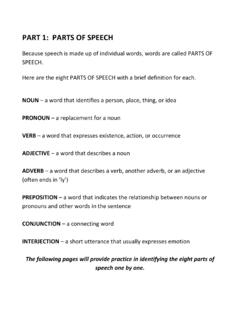
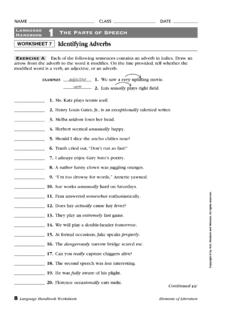
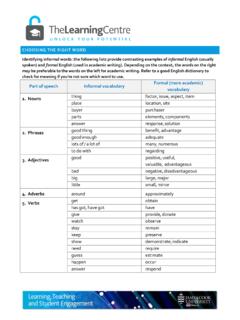
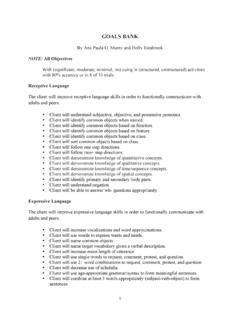
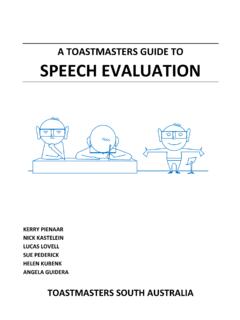
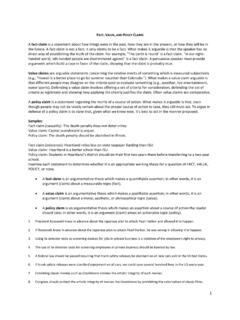
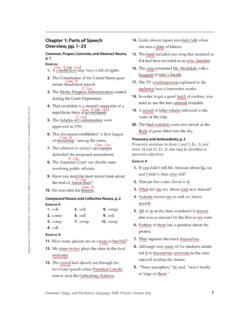
![arXiv:2006.11477v3 [cs.CL] 22 Oct 2020](/cache/preview/b/4/c/1/f/0/6/d/thumb-b4c1f06d9a16f45a66d47cafc726d437.jpg)
